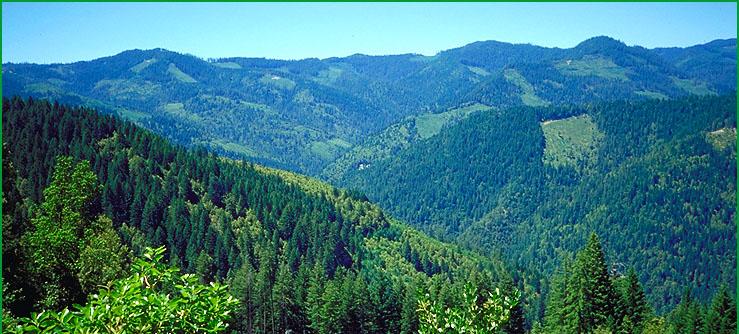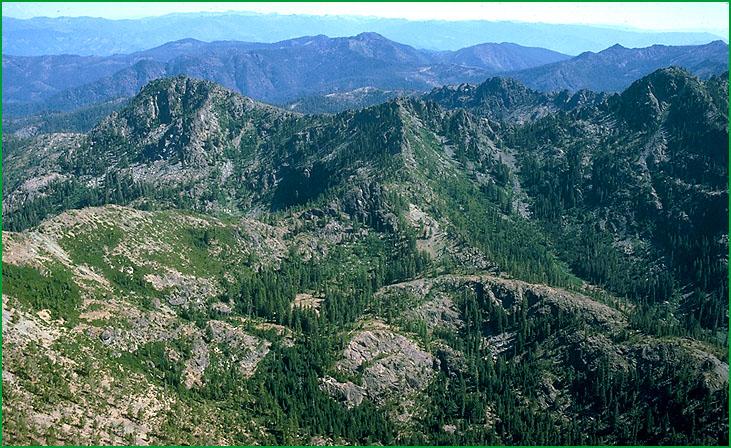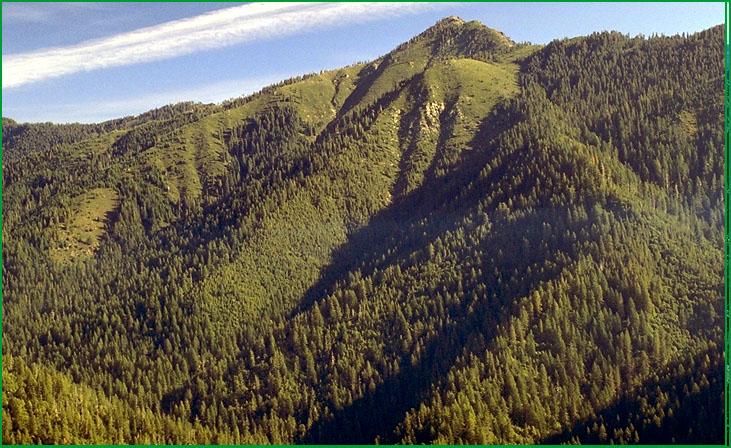 | Western Jurassic- Gasquet Mountain Ultramafics- Oregon Mountain-Siskiyou Mountains |
Western Jurassic - Smith River area Ś James R. Nelson |
Slate Creek area Ś Scott Miles |
Oregon Mountain- near Weaverville Ś David Howell |
Siskiyou Mountains - Preston Peak area Ś Tom Laurent |
Klamath National Forest Ś Jerry Mosier |
http://www.fs.fed.us/r5/projects/ecoregions/m261aa.htm
Subsection M261Aa
Western Jurassic
This subsection is in the Western Jurassic Belt. It is along the western edge of the Klamath Mountains. Marine air moderates the climate of the western part of the subsection. It has a temperate and humid climate. MLRAs 5b and 5c.
Lithology and Stratigraphy. This subsection is dominated by clastic Jurassic marine sedimentary rocks and greenstone of the Galice and Rogue formations. The sedimentary rocks have been slightly metamorphosed to form metagraywacke and slate. In the northern part of the subsection there are some serpentinized peridotite, gabbro, diabase, and volcanic rocks. The rocks are moderately to intensely folded and faulted.
Geomorphology. This is a subsection of mountains with rounded ridges, steep sides, and narrow canyons. There are narrow floodplains and high terraces along the Smith, Klamath, and Trinity Rivers and their tributaries. Both large and small landslides are common. The elevation range is about 250 to 4000 feet. Mass wasting and fluvial erosion are the main geomorphic processes.
Soils. The soils are mostly Dystric and Dystric Lithic Xerochrepts, and, from east to west, Ultic Haploxeralfs and Typic Haploxerults. Xeric Haplohumults occur on high terraces. The soils are well drained. Soil temperature regimes are predominantly mesic. Soil moisture regimes are xeric, bordering udic along the western edge of the subsection at the northern end.
Vegetation. The predominant natural plant communities are Douglas-fir - tanoak series and Douglas-fir series. Canyon live oak series is common on very steep rocky slopes with stony soils. Port Orford cedar series occurs on wet mountain sideslopes and along streams. Arroyo willow series and Mixed willow series occur in riparian areas along streams. Jeffrey pine series occur on soils formed from serpentinized peridotite.
Characteristic series by lifeform include:
Grasslands: Rocky Mountains sedge series.
Shrublands: Brewer oak series, Greenleaf manzanita series, Holodiscus series, Montane wetland shrub habitat, Mountain alder series, Sadler oak series, Tobacco brush series, Wedgeleaf ceanothus series.
Forests and woodlands: Black oak series, Canyon live oak series, Douglas-fir series, Douglas-fir - tanoak series, Incense-cedar series, Jeffrey pine series, Knobcone pine series, Oregon white oak series, Montane wetland shrub habitat, Red fir series, Western hemlock series, White alder series, White fir series.
Climate. The mean annual precipitation is about 50 to 120 inches. Most of the precipitation is rain at lower elevations, with alternating rain and snow at higher elevations. Mean annual temperature is about 45░ to 57░ F. The mean freeze-free period is about 100 days at higher elevations to 225 days at lower elevations.
Surface Water. Runoff is rapid. The Smith, Klamath, and Trinity Rivers cross the subsection. Larger tributaries are perennial and smaller streams are mostly perennial. There are no permanent lakes, although temporary and some permanent ponding occurs on and behind some landslides.
Subsection M261Ab
Gasquet Mountain Ultramafics
This subsection encompasses ultramafic rocks in the Josephine ophiolite and from the Josephine ophiolite southward along the east side of a thrust fault that separates the Coast Range mountains from the Klamath Mountains. It ends at Burrill Peak, just north of the Klamath River. Marine air moderates the climate of most of the subsection. It has a temperate and humid climate. MLRA 5b.
Lithology and Stratigraphy. This subsection is dominated by partially to completely serpentinized peridotite of a Jurassic-aged ophiolite, called the Josephine ophiolite. Some gabbro and diabase are included in the subsection.
Geomorphology. This is a subsection of mountains with rounded ridges, steep sides, and narrow canyons. Some of the mountains have broad summits. Landslides are common, particularly where the peridotite has been completely serpentinized and sheared. The elevation range is about 200 to 4800 feet. Mass wasting and fluvial erosion are the main geomorphic processes.
Soils. The soils are mostly Dystric Xerochrepts, Lithic Xerochrepts, Ultic Haploxeralfs, and Typic Haploxerults. Kandihumults occur on broad mountain summits and mountain benches. Grayer soils are in serpentinitic families and redder soils are in oxidic families. Most of the soils are well drained, but some are poorly drained. Soil temperature regimes are predominantly mesic. Soil moisture regimes are xeric.
Vegetation. The predominant natural plant communities are Jeffrey pine series and Lodgepole pine series. Port Orford-cedar series is common on wet mountain sideslopes and along streams. Douglas-fir series and Western white pine series occur on old land surfaces where most of the magnesium (Mg) has been leached from the soils. Darlingtonia series is common in small bogs and fens.
Characteristic series by lifeform include:
Grasslands: Idaho fescue series.
Seeps: Darlingtonia series.
Shrublands: Holodiscus series, Huckleberry oak series, Wedgeleaf ceanothus series.
Forests and woodlands: Douglas-fir series, Douglas-fir - tanoak series, Incense-cedar series, Jeffrey pine series, Knobcone pine series, Lodgepole pine series, Port Orford-cedar series, Western white pine fir, White alder series, White fir series.
Climate. The mean annual precipitation is about 80 to 120 inches. Most of the precipitation is rain at lower elevations, with some snow at higher elevations. Mean annual temperature is about 46░ to 57░ F. The mean freeze-free period is about 100 days at higher elevations to 225 days at lower elevations.
Surface Water. Runoff is rapid. It drains to the Smith River and tributaries of the Klamath River. There are many wet spots, or bogs, on sloping to moderately steep mountain slopes where water seeps from the ground. There are a few small lakes, and temporary ponding occurs on some landslides.
Subsection M261Ac
Oregon Mountain
This subsection is in the Central Metamorphic Belt. It stretches from the Trinity Alps southeastward between the Bully Choop and Siskiyou faults to the Great Valley. The climate is temperate and humid. MLRAs 5c and 5d.
Lithology and Stratigraphy. This subsection is dominated by Paleozoic metavolcanic rocks of the Salmon Hornblende Schist, and metasedimentary and metavolcanic rocks of the Abrams Mica Schist, or Grouse Ridge Formation, that are between the Bully Choop fault on the east and the Siskiyou fault on the west. The age of metamorphism is Devonian, which is when the Bully Choop fault was active. Oregon Mountain is an outlier, or klippe, of metamorphosed marine sedimentary rocks from the Eastern Klamath Belt. There are small areas of Lower Cretaceous marine sedimentary rocks of the Great Valley sequence and Oligocene nonmarine sedimentary rocks of the Weaverville formation.
Geomorphology. This is a subsection of mountains with rounded ridges, steep sides, and narrow canyons. There is a narrow floodplain and discontinuous terraces along the Trinity River and its tributaries. The elevation range is from about 1500 feet up to 6974 feet on Bully Choop. Mass wasting and fluvial erosion are the main geomorphic processes.
Soils. The soils are mostly Typic, Dystric, Lithic, and Dystric Lithic Xerochrepts; Ultic Haploxeralfs; and, on older surfaces, Ultic Palexeralfs. Soils on the nonmarine sedimentary deposits are mostly Mollic Haploxeralfs. The soils are well drained. Soil temperature regimes are predominantly mesic, with frigid and some cryic at higher elevations. Soil moisture regimes are xeric.
Vegetation. The predominant natural plant communities are Douglas-fir - ponderosa pine series and Mixed conifer series. Canyon live oak series is common on very steep rocky slopes with stony soils. White fir series, and some Red fir series, occurs at higher elevations.
Characteristic series by lifeform include:
Grasslands: California annual grassland series.
Shrublands: Brewer oak series, Bush chinquapin series, Chamise series, Chamise - wedgeleaf ceanothus series, Greenleaf manzanita series, Holodiscus series, Huckleberry oak series, Tobacco brush series, Wedgeleaf ceanothus series, Whiteleaf manzanita series.
Forests and woodlands: Blue oak series, Birchleaf mountain-mahogany series, Black oak series, Canyon live oak series, Douglas-fir series, Douglas-fir - ponderosa pine series, Foothill pine series, Interior live oak, Ponderosa pine series, Red fir series, Valley oak series, White alder series, White fir series.
Climate. The mean annual precipitation is about 40 to 70 inches. Most of the precipitation is rain at lower elevations, but much of it is snow at higher elevations. Mean annual temperature is about 40░ to 55░ F. The mean freeze-free period is about 50 days at higher elevations to 175 days at lower elevations.
Surface Water. Runoff is rapid. It drains to the Trinity River and its tributaries, except southeast of Bully Choop where runoff drains to tributaries of the Sacramento River. Larger streams are perennial and smaller ones are mostly ephemeral. There are no natural lakes in the subsection.
Subsection M261Ad
Siskiyou Mountains
This subsection is in the Siskiyou Mountains where they are centered along a north-south aligned drainage divide east of the Smith River. It is in the Western Paleozoic and Triassic Belt. The climate is temperate to cold and humid. MLRA 5b.
Lithology and Stratigraphy. This subsection is dominated by serpentinized peridotite, gabbro, diabase, and Paleozoic to Jurassic metavolcanic and metasedimentary rocks of Rattlesnake Creek terrane and by Mesozoic gabbro and granitic rocks. The granitic rocks are generally quartz diorite to slightly more silicic rocks. Quaternary glacial till and outwash occur in many small areas.
Geomorphology. This is a subsection of mountains with rounded ridges, steep sides, and narrow canyons. Preston Peak is an individual mountain that stands about 1000 feet or more above subequal summits of other mountains and ridges in the subsection. Cirques and moraines occur near the crest of the Siskiyou Mountains and on Preston Peak and the north side of Bear Peak. Both large and small landslides are common. The elevation range is from about 2000 feet up to 7309 feet on Preston Peak. Mass wasting and fluvial erosion are the main geomorphic processes. Glacial processes have been much less extensive.
Soils. The soils are mostly Dystric and Dystric Lithic Xerochrepts and Typic Haploxerults on metamorphic rocks; Ultic Haploxeralfs and Dystric Xerochrepts on gabbro and diabase; Dystric and shallow Dystric Xerochrepts and Typic Haploxerults on granitic rocks; and Lithic Ruptic-Xerorthentic, Typic Xerochrepts and Typic Haploxeralfs on serpentinized peridotite. Soils at the higher elevations are mostly rocky Lithic Xerumbrepts and Dystric Xerochrepts, plus Lithic, Entic, and Typic Xerumbrepts on granitic rocks and Xerumbrepts on glacial till. The soils are well drained, except in small glacial basins. Soil temperature regimes are mesic at lower elevations and frigid, with some cryic, at higher elevations. Soil moisture regimes are xeric.
Vegetation. At lower elevations, the predominant natural plant communities are Douglas-fir - tanoak series and Douglas-fir series, and, on ultramafic rocks, Jeffrey pine series. Canyon live oak series is common on very steep rocky slopes with stony soils. The higher elevations are mostly White fir series, with some Red fir series and Mixed subalpine forest series. Port Orford-cedar series occurs on some wet mountain sideslopes and along streams. There are also some unique plant communities in the Siskiyou Mountains called ōEnriched stands in the Klamath Mountainsö (Sawyer and Keeler-Wolf, 1995).
Characteristic series by lifeform include:
Grasslands: Idaho fescue series, Montane meadow habitat, Rocky Mountains sedge series.
Seeps: Darlingtonia series, Fen habitat.
Shrublands: Brewer oak series, Bush chinquapin series, Greenleaf manzanita series, Holodiscus series, Huckleberry oak series, Sadler oak series, Sitka alder series, Subalpine upland shrub habitat, Tobacco brush series, Wedgeleaf ceanothus series.
Forests and woodlands: Alaska yellow-cedar stands, Douglas-fir series, Enriched stands in the Klamath Mountains, Incense-cedar series, Jeffrey pine series, Knobcone pine series, Lodgepole pine series, Mixed subalpine forest series, Mountain hemlock series, Port Orford-cedar series, Red fir series, Western white pine series, White fir series.
Climate. The mean annual precipitation is about 60 to 100 inches. Most of the precipitation is rain at lower elevations, but much of it is snow at higher elevations. Mean annual temperature is about 40░ to 53░ F. The mean freeze-free period is about 50 days at higher elevations to 175 days at lower elevations.
Surface Water. Runoff is rapid. It drains to the Smith River on the west and to the Klamath River and its tributaries on the east. Larger tributaries are perennial and smaller streams are mostly perennial. There are some small lakes, or ponds, in cirque and paternoster basins. Temporary ponding occurs on some landslides




